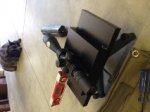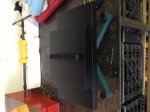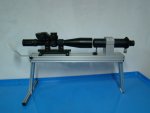I have two high end(3000$ plus) scopes from the same manufacturer, same model, different reticles. I have been shooting out to 1730 yards and noticed that i was off about a mil on elevation. I chalked it up to my magnetospeed being off, and used my ab kestrel and did a mv calibration test at 1600 yards. My magnetospeed showed 2840 fps, single digit es, and the mv calibration showed me at 2940 fps. It is a custom 338 lapua, but standard chamber and 29" barrel, so i really doubted that number, but my drops were working out so i just rocked on. I got a random idea to box test them this morning in my back yard at 100 yards, with a long 2x6 i had around. I zeroed at 100, and then dialed up 15.5 mils, which should have been 55.8 inches. shot and my bullet impacted at 59.7 inches, over a mil high. Both scopes, different gun and different calibers, both hit at 59.7 to 59.8 inches difference, so it wasnt just one. I dont have any other brands to compare it to, but will ask yalls opinion. Personally, i expected it to be off no more than half an inch for this test. Am i expecting too much? What do your scopes hold as far as tracking tolerance? Should i send them in and have them fixed, or just adjust my click values in my ballistics program and rock on? And before anyone asks, i am not going to tell which scopes they were, because this forum is too big, and google picks up way too much in search results, and the company deserves the right to fix the problem and address others concerns if warranted. So, what does the hide say? Thank you, Greg
Join the Hide community
Get access to live stream, lessons, the post exchange, and chat with other snipers.
Register
Download Gravity Ballistics
Get help to accurately calculate and scope your sniper rifle using real shooting data.

Install the app
How to install the app on iOS
Follow along with the video below to see how to install our site as a web app on your home screen.
Note: This feature may not be available in some browsers.
You are using an out of date browser. It may not display this or other websites correctly.
You should upgrade or use an alternative browser.
You should upgrade or use an alternative browser.
Acceptable Elevation Tracking tolerance
- Thread starter dumbbell
- Start date
I've done that test with SWFA, Leopold VXIII, Vortex Viper PST, and Vortex Razor. I only do 10 mils, and have never been off more than my ability to resolve the centers of the groups, maybe 1/2" between the two. There was plenty of resolution to figure out if the Leopold was .25" or .25 moa. Same thing when checking the reticles.
What happens when you do that test on the reticle?
What happens when you do that test on the reticle?
Personally I would send it back, but if it is consistent then you could use it that way. It may not be linear, it might track fine say up to ten mils or so and then start running off. You could test with a round at each mil on the way up and down and see if it is consistent, if so you could run your dope and then add your correction factor. I might be willing to do that for a sub $1000 scope but you paid 3k so you don't have to do stuff like that.
Horus vision makes a target to check scope tracking: which will assist you, it will be the 36" X 96" target.: http://www.horusvision.com/img/pr_4_cats.gif Horus Vision CATS Targets Part 1 - YouTube
I have not checked the reticle, but i plan on it now. And that is an excellent idea to check each mill on the way up. I will def do that asap.
Any other opinions or experience with other high end scopes? Thanks for the replies guys
Any other opinions or experience with other high end scopes? Thanks for the replies guys
Calibrating your scope to your Ballistics program
It's a common practice to calibrate any new scope prior to mounting on a rifle.
This is done in an area that has been measured to an exact 100 yards by means of a measuring tape then have a 72" carpenters rule hung on a wall that is plumbed a true vertical. On the opposite end is the scope mounted in a one piece scope mount held in a vice solid with reticle squared with the ruler. Now with the crosshairs at the top of the rule dial the turret and see if it ends up correctly as dialed in either moa or mils.
The amount of error will increase .
This is a result of how aggressive or not the the threads are milled at. This does not matter if its a Night Force Schmitty, Vortex etc.
You then can go into your program and do a correction factor adjustment in your ballistics program to correct the difference in adjustment needed.
Cheers
It's a common practice to calibrate any new scope prior to mounting on a rifle.
This is done in an area that has been measured to an exact 100 yards by means of a measuring tape then have a 72" carpenters rule hung on a wall that is plumbed a true vertical. On the opposite end is the scope mounted in a one piece scope mount held in a vice solid with reticle squared with the ruler. Now with the crosshairs at the top of the rule dial the turret and see if it ends up correctly as dialed in either moa or mils.
The amount of error will increase .
This is a result of how aggressive or not the the threads are milled at. This does not matter if its a Night Force Schmitty, Vortex etc.
You then can go into your program and do a correction factor adjustment in your ballistics program to correct the difference in adjustment needed.
Cheers
I built a 60 plus pound steel plate with picitinny rail screwed down and JB welded to the top just for scope calibration since I was having some concerns of my own on 3 different NF scopes that I use. I took a wood 1x2 about 8ft long and put two marks on it exactly 60" apart from one another. placed it out exactly 100yds(using my rag tape) and zeroed my scopes to the top mark. then I counted clicks till it was at the lower 60" mark. both of my 3.5x15 nightforces were dead nuts. but my newley acquired ATACR was out a bunch at 1000yds it was off about 18". I now calibrate any scope I plan on using at distance no matter the cost.
my scope calibrator

my scope calibrator


If the reticle agrees with the turrets, you're likely at something a bit further than 100 yards.
Good point, and something i will double check when i test it again. No doubt i am usually the cause of any error in my shooting, but my test this morning lines up with how much i seem to be off at 1730. It took me 15.7 mils to hit at that distance last night, and there is no way in hades that my magnetospeed is off that much(it shows 2840), much less that my standard 338 lapua with a 29" barrel and 91gr of h1000 under a 300 gr hybrid is shooting 2940fps, which is what it would take for that dope to match. Good reminder that a box test requires exact distance for meaningful measurements, tho. Thank you
I like that set up!!!I built a 60 plus pound steel plate with picitinny rail screwed down and JB welded to the top just for scope calibration since I was having some concerns of my own on 3 different NF scopes that I use. I took a wood 1x2 about 8ft long and put two marks on it exactly 60" apart from one another. placed it out exactly 100yds(using my rag tape) and zeroed my scopes to the top mark. then I counted clicks till it was at the lower 60" mark. both of my 3.5x15 nightforces were dead nuts. but my newley acquired ATACR was out a bunch at 1000yds it was off about 18". I now calibrate any scope I plan on using at distance no matter the cost.
my scope calibratorView attachment 35981View attachment 35982
I like that set up!!!
it's a no nonsense setup. torque base down to picitinny rail. align crosshairs with a plumb bob and torque rings. then take it out to 100yds and verify click values. you can kick my jig and not move it at all.
In our workshop we test the tracking and actual clicks value of our customers' scopes, through an Hensoldt/Zeiss optic device (see the picture); it's a really accurate instrument.
After more than ten years of tests, I can tell you that we never saw an error of more than 0.1mil, with a single top brand only, that's Nightforce. With other top brand scopes, along with exemplars with almost zero error, we found sometime errors from 0.3 to 1.2mil (3% to 12%!!), along a 10mil travel, compared to the nominal value (0.1mil)
After more than ten years of tests, I can tell you that we never saw an error of more than 0.1mil, with a single top brand only, that's Nightforce. With other top brand scopes, along with exemplars with almost zero error, we found sometime errors from 0.3 to 1.2mil (3% to 12%!!), along a 10mil travel, compared to the nominal value (0.1mil)
Attachments
I personally do not think that is acceptable. Maybe I'd deal with that difference on a $1k scope but for that kind of money my expectations would be completely accurate and repeatable turrets and great glass, nothing less. He'll, If I were a company rep I wouldn't want a scope with our name on it performing like that.
Double check to make sure your shooting at exactly 100 yards. If so and you still having a large error send it in to get checked. My Kahles was off over 7% when I first got it. I sent it in and now it's less than 1/2%. I know you can apply a correction factor to most ballistic solvers, but for the price of some of these scopes they should track perfectly.
http://www.snipershide.com/shooting...es/244819-tall-target-test-check-my-math.html
http://www.snipershide.com/shooting...es/244819-tall-target-test-check-my-math.html
I show you at .11056 Mil per click. That more than 10% error, and I would think that's not acceptable. I'm OK with up to 5%, just because of tolerances in the build, but that's pretty much my limit.
I have everyone test tracking during the XLR class, and I've never seen a scope off that much. Be very careful to measure EXACTLY 100 yards to the turret, not with a LRF, but with a tape measure. I don't shoot these tests, I use a laser boresight and mark the laser from zero then up every 5 mils to 20. This eliminates shooter and zero errors.
I'd test the reticle while you are at it, 1 Mil at 100 yards is 3.6", 36" to 10 mil
I have everyone test tracking during the XLR class, and I've never seen a scope off that much. Be very careful to measure EXACTLY 100 yards to the turret, not with a LRF, but with a tape measure. I don't shoot these tests, I use a laser boresight and mark the laser from zero then up every 5 mils to 20. This eliminates shooter and zero errors.
I'd test the reticle while you are at it, 1 Mil at 100 yards is 3.6", 36" to 10 mil
I show you at .11056 Mil per click. That more than 10% error, and I would think that's not acceptable. I'm OK with up to 5%, just because of tolerances in the build, but that's pretty much my limit.
I have everyone test tracking during the XLR class, and I've never seen a scope off that much. Be very careful to measure EXACTLY 100 yards to the turret, not with a LRF, but with a tape measure. I don't shoot these tests, I use a laser boresight and mark the laser from zero then up every 5 mils to 20. This eliminates shooter and zero errors.
I'd test the reticle while you are at it, 1 Mil at 100 yards is 3.6", 36" to 10 mil
I wanted to update this since i figured out like most things, i was the source of the problem. First, i wasnt at exactly 100 yards. I bought a 300 ft tape and that fixed alot of it. second, until cory mentioned it, it has never occured to me that you measure from the target to your elevation turret. i always measured to the end of the barrel. So, both of my Kahles scopes are off 2% or a little less.
Next, as to why i seemed to be so off when shooting at a mile. I was shooting prone, on relatively flat ground, in humid humid arkansas. Even tho i could see the target, undoutedly the mirage close to the ground was doing some bad voodoo on my poa. When i got off the ground and started shooting off the roof of my truck, my elevation started matching up with my AB kestrel. Same thing even at shorter distances with my 6.5-284. I would dial my confirmed dope for 600 yards, shoot, and be over my target my .2-.3 mils. When i would get up and shoot positionally, hit after hit after hit. So, know that i have shown my ignorance, hopefully this might help others in the future. Greg
Good to know. Thanks for the update Greg. In any case, the resulting thread has been very educational and helpful.
Similar threads
- Replies
- 34
- Views
- 2K
- Replies
- 22
- Views
- 1K
- Replies
- 111
- Views
- 5K

